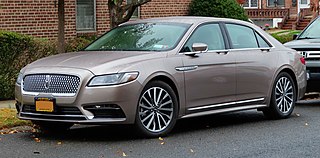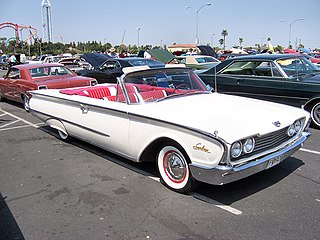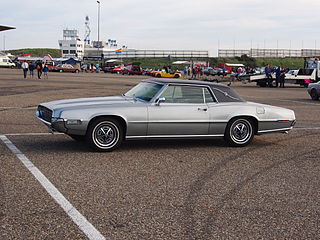
The Ford Thunderbird is a personal luxury car manufactured and marketed by Ford Motor Company from model years 1955 to 2005, across 11 generations. Introduced as a two-seat convertible, the Thunderbird was offered variously as a four-seat hardtop coupe, four-seat convertible, five-seat convertible and hardtop, four-door pillared hardtop sedan, six-passenger hardtop coupe, and five-passenger pillared coupe, with the final generation designed again as a two-seat convertible.

The Ford Galaxie is a car that was marketed by Ford in North America from the 1959 to 1974 model years. Deriving its nameplate from a marketing tie-in with the excitement surrounding the Space Race, the Galaxie was offered as a sedan within the full-size Ford range throughout its production run. In the full-size segment, the model line competed against the Chevrolet Impala and Dodge Polara.

The Chevrolet Chevelle is a mid-sized automobile that was produced by Chevrolet in three generations for the 1964 through 1977 model years. Part of the General Motors (GM) A-body platform, the Chevelle was one of Chevrolet's most successful nameplates. Body styles included coupes, sedans, convertibles, and station wagons. The "Super Sport" versions were produced through the 1973 model year and Lagunas from 1973 through to 1976.

The Ford Country Squire is a series of full-size station wagons that were assembled by American automaker Ford. Positioned as the top-level station wagon of the Ford division, the Country Squire was distinguished by woodgrain bodyside trim. From 1950 through the 1991 model years, eight generations of the Country Squire were produced. Following the discontinuation of Edsel Bermuda, Mercury marketed the Mercury Colony Park as a divisional counterpart of the Country Squire, sharing bodywork and trim while the Mercury was not available with a six cylinder engine and was more expensive due to the optional equipment on the Ford that was standard on the Mercury.

The Mercury Cougar is a series of automobiles that was sold by Mercury from 1967 to 2002. The model line is a diverse series of vehicles; though the Cougar nameplate is most commonly associated with two-door coupes, at various stages in its production, the model also was offered as a convertible and a hatchback. During its production as the mid-size Mercury line, the Cougar was also offered as a four-door sedan and five-door station wagon.

The Lincoln Continental is a series of mid-sized and full-sized luxury cars produced between 1939 and 2020 by Lincoln, a division of the American automaker Ford Motor Company. The model line was introduced following the construction of a personal vehicle for Edsel Ford, who commissioned a coachbuilt 1939 Lincoln-Zephyr convertible, developed as a vacation vehicle to attract potential Lincoln buyers. In what would give the model line its name, the exterior was given European "continental" styling elements, including a rear-mounted spare tire.

The Ford LTD is a range of automobiles manufactured by Ford for the 1965 to 1986 model years. Introduced as the highest trim level of the full-size Ford model range, the LTD moved the Ford range upmarket, offering options and features previously reserved for Mercury and Lincoln vehicles. For much of its production life, the LTD competed against the Chevrolet Caprice ; the Mercury Marquis served as its divisional counterpart from 1967 until 1986.

The Buick LeSabre is a full-size car made by the division Buick of General Motors from 1959 until 2005. Prior to 1959, this position had been retained by the full-size Buick Special model (1936–58). The "LeSabre", which is French for "the sabre", was Buick's mid-level full-size sedan above the Special but below the Electra during the 1960s then remained in its market position when the Electra was replaced with the Park Avenue. The LeSabre was available as a 2-door convertible, sedan or hardtop, a 4-door sedan or hardtop and station wagon throughout its production.

The Mercury Montclair is a series of full-size sedans that were manufactured and marketed over five generations by the Mercury division of Ford. The nameplate was used by the division twice, from the 1955 to the 1960 model years and from the 1964 to the 1968 model years. The model was offered as two-door and four-door hardtops, four-door pillared sedan, and a two-door convertible.

The Ford Fairlane is an automobile model that was sold between the 1955 and 1970 model years by Ford in North America. Taking its name from the Dearborn, Michigan estate of Henry Ford, the Fairlane nameplate was used for seven different generations of vehicles. Through its production, the model line would be marketed in a wide variety of body styles, including two-door and four-door sedans, two-door and four-door hardtops, station wagons, and both traditional and retractable-hardtop convertibles.

The Ford Starliner was a full-size, two-door, fastback variant of the flagship Galaxie, manufactured and marketed by Ford Motor Company for model years 1960 and 1961.

Leading into the 1950s, Ford, along with many other top of the market car manufacturers were capitalizing on the post war boom. Many new advancements in technology and products were being developed during this time that allowed for cars going into the future to have features never seen before or features that were not normal until now. The automatic window, for example, was a new feature that made Americans see their current cars as outdated and technologically behind. The 1960s were one of the best eras for the production of cars, as the war between Ford and Chevrolet heated up and produced some of the most classic and recognizable cars in America still to this day.

The Mercury Monterey is a series of full-size cars that were manufactured and marketed by the Mercury division of Ford from 1950 to 1974. Deriving its name from Monterey Bay, the initial Mercury Monterey served as the top-of-the-line two-door sedan model for 1950 and 1951 to compete with the hardtop models of Oldsmobile and Buick. It came with a vinyl roof covering, upgraded upholstery, and other features. The hardtop was introduced for 1952. During its production, the Monterey would be offered in multiple body styles, ranging from coupes, convertibles, sedans, hardtops, and station wagons.

The first-generation Ford Mustang was manufactured by Ford from March 1964 until 1973. The introduction of the Mustang created a new class of automobiles known as pony cars. The Mustang's styling, with its long hood and short deck, proved wildly popular and inspired a host of competition.

The third generation of the Ford Thunderbird is a personal luxury car produced by Ford for the 1961 to 1963 model years. It featured new and much sleeker styling than the second generation models. Sales were strong, if not quite up to record-breaking 1960, at 73,051 including 10,516 convertibles. A new, larger 390 cu in (6.4 L) FE-series V8 was the only engine available. The Thunderbird was 1961's Indianapolis 500 pace car, and featured prominently in US President John F. Kennedy's inaugural parade, probably aided by the appointment of Ford executive Robert McNamara as Secretary of Defense.

The fifth generation Ford Thunderbird is a large personal luxury car series, produced by Ford for the 1967–1971 model years.

The eleventh generation of the Ford Thunderbird is a two-seat convertible manufactured and marketed by Ford from 2001 to 2005 for model years 2002 through 2005. It followed a five-year hiatus of the Thunderbird after the 1997 discontinuation of its tenth generation.

The Mercury S-55 is a full-size car that was marketed by the Mercury division of the Ford Motor Company during the 1960s. Developed as a performance-oriented version of the mid-level Mercury Monterey, the S-55 was the largest vehicle of the Mercury "S" (Special) range introduced in 1962; its Ford equivalent was the Ford Galaxie 500XL and competed in the full-size luxury sport coupe market segment against the Chrysler 300H.

The fifth generation of the Chevrolet Impala is a line of full-size cars produced by Chevrolet from the 1971 to 1976 model years. The largest generation of the model line, the fifth-generation Impala grew to a 121.5-inch wheelbase

The Chevrolet Impala (fourth generation) are full-size automobiles produced by Chevrolet for the 1965 through 1970 model years. The 1965 Impala was all new, while the 1967 and 1969 models featured new bodies on the same redesigned perimeter frame introduced on the 1965 models. All Impalas of this generation received annual facelifts as well, distinguishing each model year. Throughout the early 1960s, Chevrolet's basic body designs became increasingly subtle, while the bright trim that was part of the Impala package added more than a touch of luxury to the look. The same pattern was followed in the interiors, where the best materials and equipment Chevrolet had to offer were displayed. In short, the Impala was on its way to becoming a kind of junior-grade Cadillac, which, for both the company and its customers, was just fine.

























